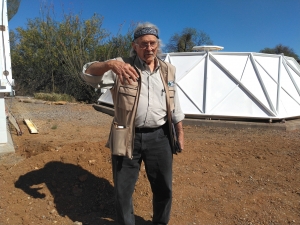(Trent, Phil, and Kai have received full COVID vaccinations and were outdoors for the duration of this visit)
In the academic world the apprenticeship model is cornerstone to the transmission of knowledge and skills, made strong through the publication of research, experiment design, and data. Outside of academia, the world often takes for granted how we arrived to our knowledge base, to our technological prowess and industrial fortitude.
In our work on the Test Module, the prototype for the Biosphere 2 and now centerpiece for SAM, we have asked myriad questions (in our minds) of the Biospherians, Why did they build it that way? What was this used for? How did they come up with this idea? and What happens if we replace that with this? Taber MacCallum and William Dempster have been gracious with support and guidance via remote. In our pandemic riddled world it was unexpected to spend time with the third member of this design and engineering team, an individual who helped lay the foundation for the Test Module in which we stand. Today we had the honor of receiving Phil Hawes, architect of record (1985 -1992) for Biosphere 2 who worked closely with Dempster and MacCallum to design and build the Test Modules in 1986-87.
 Phil spent the better part of two hours with us, telling stories of the architecture, technology, biology and ecology, and social dynamics that made Biosphere so unique. He emphasized (as needs to be emphasized again and again) that no experiment “fails” as long as we learn from the outcome. The failure would be to not learn from those aspects of the experiment that unfolded in ways unexpected.
Phil spent the better part of two hours with us, telling stories of the architecture, technology, biology and ecology, and social dynamics that made Biosphere so unique. He emphasized (as needs to be emphasized again and again) that no experiment “fails” as long as we learn from the outcome. The failure would be to not learn from those aspects of the experiment that unfolded in ways unexpected.
Following his departure Trent and I (Kai) repeated the mantras shared by Phil, an echo from more than three decades prior that needs to be shared now even more than before:
- “Throw your heart in front of you and then run to catch up!”
- “Take risks and have adventures!”
- “Courage!” to do bold things that others will say can’t be done.
Sometimes leaders accomplish difficult tasks by act of will alone, for competition, or for profit. But those who truly shape the next generation do what they do because they love doing it. Others follow as a celebration of the process and the goal. Phil is relentless in his pursuit of the art and science of sustainable living both on this planet and beyond. He shared with us photos of a scale model he recently completed for a 19 acre sustainable community in Fairfield, Iowa. It was beautiful in its simplicity, layout, and flow. Thank you Phil for bringing us into your past and present as we move to reshape our shared future, on this planet and beyond.
One of the most knowledgeable and dedicated green architects on this planet, Phil Hawes has been a leading pioneer in alternative design and construction for more than 40 years. He has worked on projects in sustainable design, and educational programs in architecture, ecology, and community planning in California, Arizona and Washington State, and in Portugal, France, Nepal, and Australia; he continues his work in sustainable community development. Phil studied with Frank Lloyd Wright at Taliesin West in 1955-56. He holds a B.A. in Architectural Design from the University of Oklahoma and a Ph.D. in Sustainable Community Design from the San Francisco Institute of Architecture.


